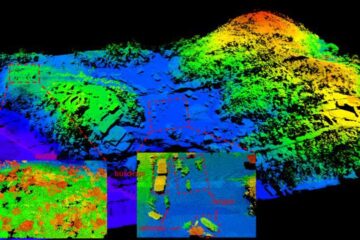Amazon Basin sediment accumulation influenced by La Niña

Enormous quantities of sediment are deposited in the flood-plains traversed by the Amazon and its tributaries in times of flooding. Scientists have hitherto considered the sedimentation rate to be generally constant with time.
Research conducted jointly by the IRD, the Universities of Washington1 and California2 and the Bolivian National Meteorology and Hydrology Service (SENAMHI) of La Paz, on two Bolivian rivers shows on the contrary that such events are irregular and less frequent than has been thought. These results, just published in Nature, emphasize that, in this Andean-Amazonian foreland, sedimentation is closely dependent on the flood amplitude, in turn linked to climatic variability, and particularly to La Niña, the cold phase of the ENSO (El Niño Southern Oscillation).
Continental-scale rivers can transport enormous sediment loads. In periods of flood, a proportion of these is deposited on flood-plains. In the Amazon Basin, crossed by the Earth’s largest river, great volumes of such sequestered sediment accumulations occur. This is especially so in the Llanos, the Bolivian lowland flood-plains which stretch from the foot of the Andes. An estimated 100 to 150 million tonnes of sediment are deposited each year respectively in the Rio Beni and the Rio Mamore flood-plains. These are the two Andean tributaries of the Rio Madeira, one of the Amazon’s main tributaries and source of more than half the sediment load transported by that river.
The inter-annual sediment accumulation rate has up to now been considered to be generally constant. Now a study conducted in the floodplain which receives these two tributaries refutes this. It is the first to reveal an episodic pattern. During the past century, large sediment accumulation events indeed occurred only quite infrequently (11 events recorded over 90 years of analysis), corresponding to an average recurrence interval of eight years.
These results were the fruit of investigations forming part of the HyBAm (Hydrogéodynamique du Bassin amazonien) programme, conducted by a joint research team involving the IRD (working in the combined research unit UMR LMTG-CNRS-IRD- Paul Sabatier University of Toulouse), the Universities of Washington1 and California2, and the Bolivian National Meteorology and Hydrology Service (SENAMHI) of La Paz. 210Pb3 activity profile analysis on 300 sediment cores sampled from the Beni and Mamore basin flood-plains, interpreted using a new geochronological model developed by the University of Washington,1 enabled them to date discrete sedimentary packages to near-annual resolution. They revealed evidence of an episodic pattern in the main sedimentation events.
Why does sediment accumulation in this part of the Amazon Basin show an episodic pattern? Climatic variability plays a prime role. The team established a significant correlation between these periods of mass sediment deposition and La Niña, the cold phase of the ENSO (El Niño Southern Oscillation) climatic cycle. During most La Niña years over the past century, the Andean relief has been subjected to torrential rainfall generating fierce flooding and intensive mechanical erosion on the Andean slopes. Recordings from a hydrological station situated at the foot of the Andes showed this.
Measurements were continued and followed up in the Hybam programme. When these floods occur, huge volumes of sediment are eroded from the Andean piedmont sub-basins and transported towards the floodplain. For a proportion of these sediments to have been deposited there (for example up to 40% in the Beni Basin flood-plain), the researchers estimate that the water-level rise, during these years of high sedimentation rate, must have been extremely rapid, in excess of 8 000 m3/s. The floods would then have reached the force necessary to cut crevasses in small natural levees along the main stems of the Beni and Mamore rivers and inundate a large expanse of the plain.
With the new data the research team also studied the century-long depositional history in the floodplain of mercury associated with fine particles and the role of these in trapping metal elements transported by the great Amazonian rivers and their tributaries. Also brought to light was a strong increase, over the past 30 years, of mercury concentrations in the sediment particles deposited in the Rio Beni plain. This corresponds to the recent “boom” in gold prospecting, now at an end, but also to the colonization of new arable land on the steep flanks of the Andean piedmont.
Media Contact
More Information:
http://www.ird.fr/fr/actualites/fiches/All latest news from the category: Earth Sciences
Earth Sciences (also referred to as Geosciences), which deals with basic issues surrounding our planet, plays a vital role in the area of energy and raw materials supply.
Earth Sciences comprises subjects such as geology, geography, geological informatics, paleontology, mineralogy, petrography, crystallography, geophysics, geodesy, glaciology, cartography, photogrammetry, meteorology and seismology, early-warning systems, earthquake research and polar research.
Newest articles

A universal framework for spatial biology
SpatialData is a freely accessible tool to unify and integrate data from different omics technologies accounting for spatial information, which can provide holistic insights into health and disease. Biological processes…

How complex biological processes arise
A $20 million grant from the U.S. National Science Foundation (NSF) will support the establishment and operation of the National Synthesis Center for Emergence in the Molecular and Cellular Sciences (NCEMS) at…

Airborne single-photon lidar system achieves high-resolution 3D imaging
Compact, low-power system opens doors for photon-efficient drone and satellite-based environmental monitoring and mapping. Researchers have developed a compact and lightweight single-photon airborne lidar system that can acquire high-resolution 3D…





















